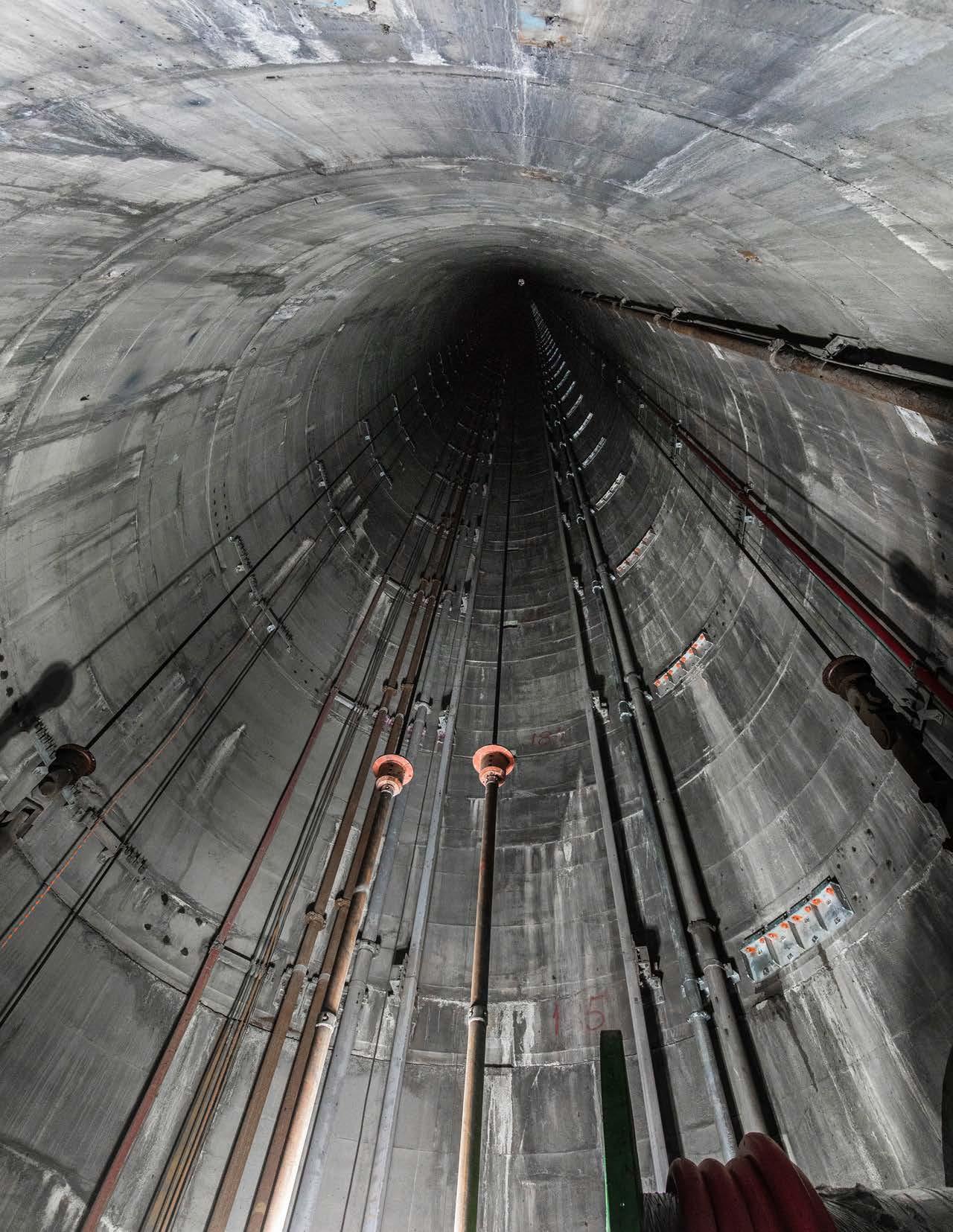60+ YEARS OF EXPERIENCE
INNOVATION AND TECHNOLOGY APPLICATIONS
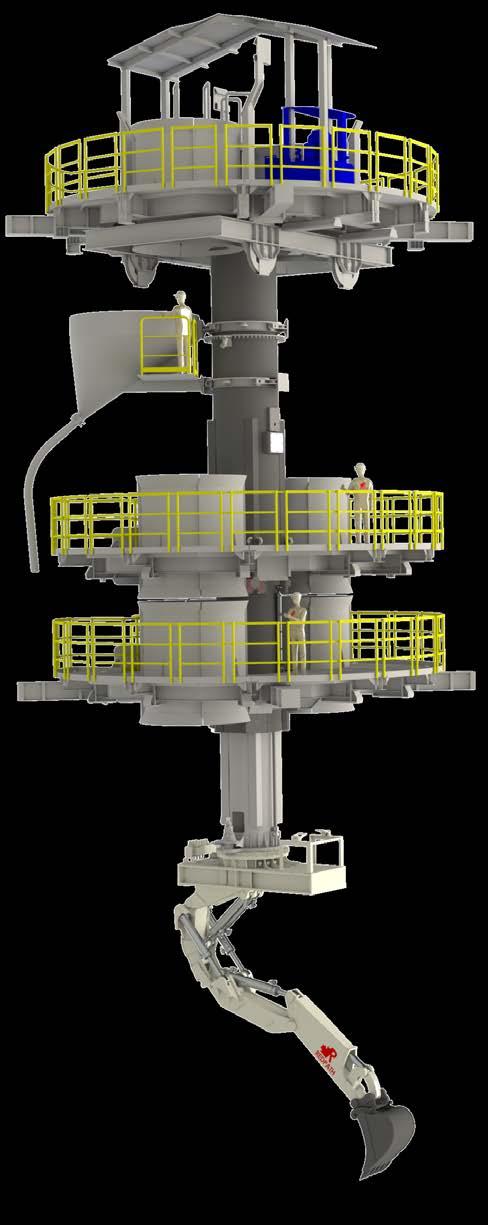
500 SHAFTS
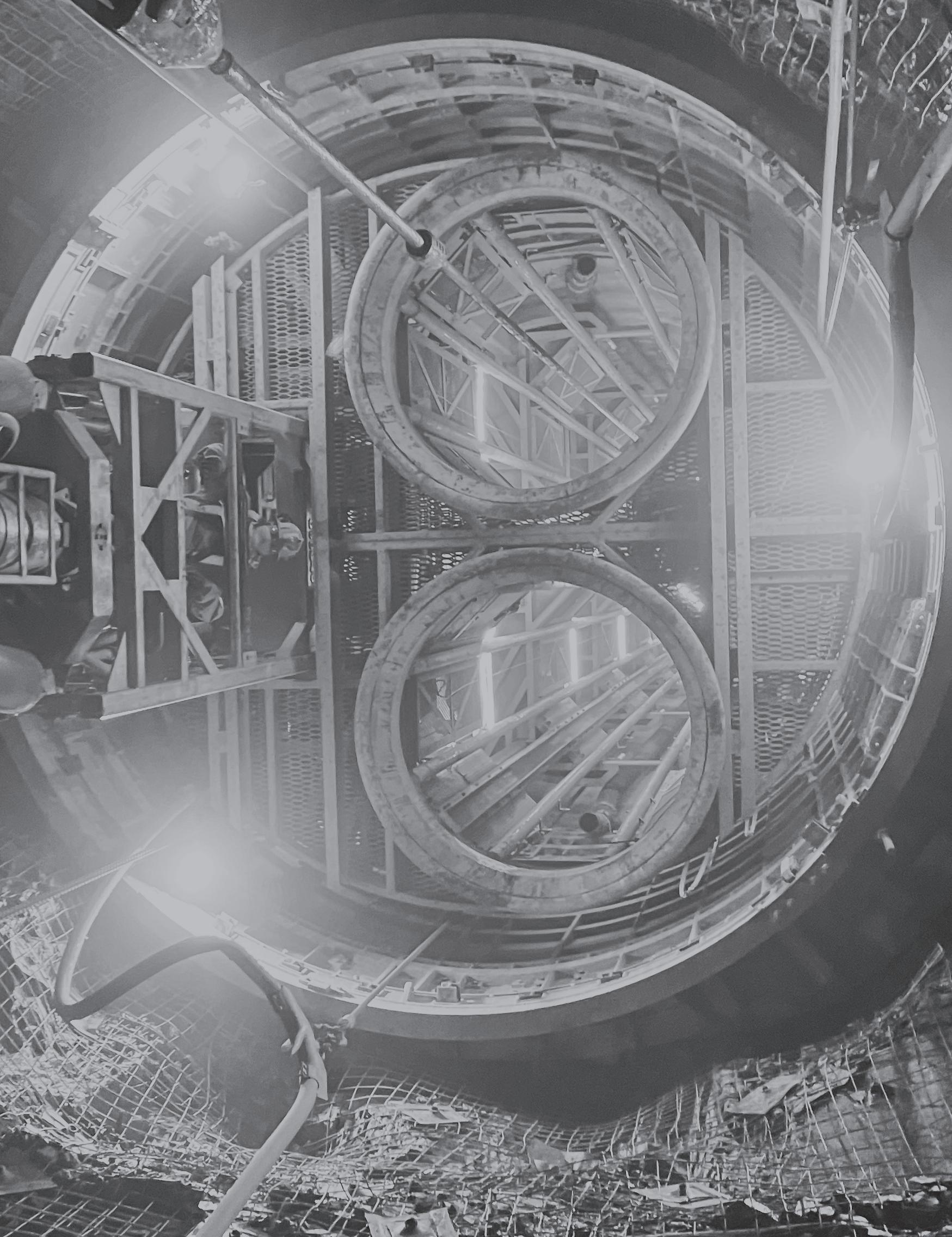

60+ YEARS OF EXPERIENCE

500 SHAFTS

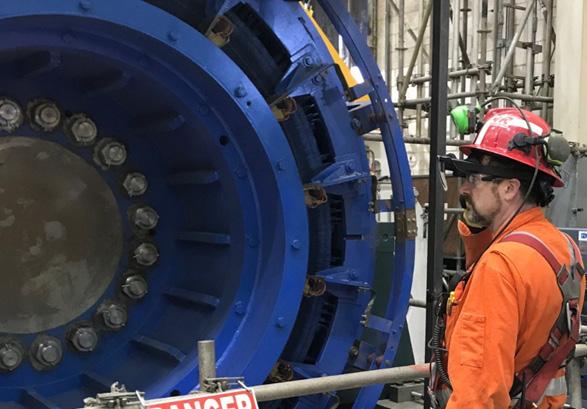
Innovation and Technology
Applications in Shaft Sinking
Connecting Field and Office Teams
Wireless Communications pg. 4



Proprietary Step-Change Methodologies
pg. 10 Current SBC Collaboration - Results 03
RECENT INNOVATION: Emergency Stop Control
With over 60 years of global shaft sinking experience, Redpath leverages its extensive technical and operational expertise to consistently challenge the status quo. As market demands evolve, Redpath is committed to developing and implementing innovative, safe, and cost-effective techniques in its shaft sinking programs.
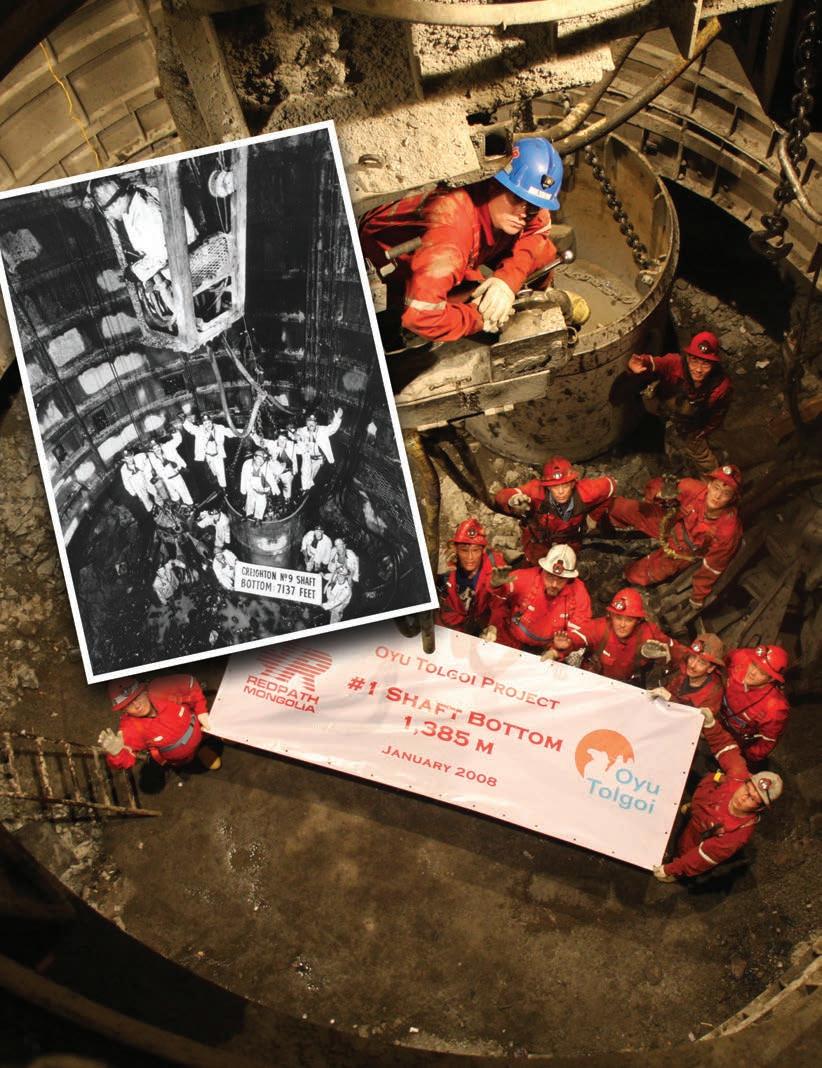
From the early days of developing full-face shaft sinking with cut drill machines, pneumatic telescopic shaft muckers, mechanical shaft boring, and auto bucket dumping innovations, to today’s unparalleled demand for increased safety, productivity, and skills training, Redpath’s engineering teams have consistently introduced groundbreaking sinking applications.
Recent developments focus on addressing the industry’s labour challenges by making systems safer, quicker, and easier to train new employees on. Recognizing that skills training is crucial for project success, these simpler systems significantly reduce training times, allowing a larger number of new employees to join the shaft-sinking fraternity.

Experts (SMEs) to our global projects has always been a challenge. Today, Redpath field teams can communicate directly with the home office online through real-time POV video calling and third-party “smart glasses” technology. This eliminates the need for additional travel time and expenses,
allowing us to analyze digital activity records to reveal hidden trends, enhance compliance, and increase transparency. The ability to troubleshoot and commission hoisting plants with remote expert assistance greatly improves our effectiveness and response times for critical project milestones.
Various types of smart glasses aid with addressing and confirming critical tasks or live status as the operator’s field of view is shared in real time with home-office engineers.
The operator’s field of view is shared live with home office engineers, while the home office computer screens can project onto the glasses, enabling field personnel to view drawings, diagrams, procedures, and more. This significantly aids in addressing and confirming critical tasks or live status updates.
The introduction of wireless communications has led to substantial development of enhanced safety features throughout the sinking plant. Using a combination of hardwired and wireless technologies and protocols, the Redpath Shaft Control System can collect information from virtually any electronic device on the market in real time to maintain operations within anticipated parameters.
We have developed crosshead signaling (or belling), powered by generators placed on the operating crosshead itself. Wireless communication has also allowed us to mount cameras on both the crossheads traveling in the shaft and at the various decks of the galloway (work stage/sinking stage). This setup monitors entry and exit at the shaft bottom. Additionally, the monitoring of the crosshead rope-button release and latch-arm positions is transmitted wirelessly to the safety control circuit, providing a solution to the age-old problem of incomplete crosshead detachment and release issues.
The bucket position entering the galloway is also monitored, providing feedback on “out of normal” occurrences and appropriate control actions to the hoist. The Redpath Shaft Obstruction System is fully integrated into the hoist controller and overrides the independent hoist control at the chairs and dump positions.
Panels with animation provide real-time monitoring of the sinking system. These panels display hoist positioning, winch duty, suspended loads, shaft obstruction status, gas monitoring, ventilation, and the status of all safety switches in the system for the dump, collar, chairs, and stage. The installation of physical shaft “switches” is no longer required, as positioning sensors are now mounted on the crossheads, with easy-to-install reflector strips placed at appropriate locations in the shaft and headframe.

A recent innovation on a complex shaft remediation job, involving multiple hoist (winders) and rehabilitation platforms operating in the same shaft, was the implementation of a stage-operated winder/hoist emergency stop control on the work platforms. This allows shaft operators working on the suspended stages to “stop” or “jog” conveyances from the shaft bottom, eliminating concerns
of congestion and multiple conveyance operating risks. Additionally, guide sensors were used on the work platforms. Due to the need to remove guides during rehabilitation, each stage traveling in the shaft controlled the hoist to prevent lowering into sections where guides had been removed during the replacement process.
3D image of conveyances utilized for shaft rehabilitation where wireless safety devices were integrated to perform work.
A unique safety feature currently in use is the shaft bells position identifier, which communicates to the hoist operator where the shaft signals (or bells) have been rung from. Programs can be adapted to provide guidance on hoisting logic, adding an extra layer of security. One current logic line requires the signal at the shaft bottom to be rung before the hoist can proceed through the galloway to the shaft bottom. If not rung, the hoist cannot proceed or may be signaled from another location. This level of control cannot be achieved with standard hardwired signaling systems. All shaft signaling is PLC controlled, and hoist operators have Wi-Fi connectivity to the stage, providing camera views of each work area.
Laser scanners at the collar and sub-collar doors have been developed to ensure the doors are clear of obstructions before opening and closing. This has been further enhanced with the application of “slinging” laser scanners that identify slung loads and integrate conveyance location, requiring the conveyance to be in a predetermined position before
the doors are closed. The components being slung can be identified with wireless ID tags, which automatically notify the hoist operator where the conveyance must be spotted before the doors can be activated, avoiding inadvertent closing on the slung load. A similar approach at the galloway underwind can be automatically linked to this position at the shaft bottom.
Bucket movement warning alarms (both visual and audible) have been developed to alert personnel of any bucket movements within the confines of the galloway. Additionally, the complete bratticing and interlocking of brattice doors with the hoist have been implemented. The level of safety introduced by these advancements has been significant.
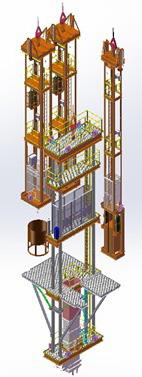
new sinking hoist operators, it also allows Redpath to test and validate new logic within the safety systems for existing or new projects. This significantly reduces the actual field-commissioning times on hoist plants by pre-proving logic and interface with the hoist controls.
A recent development by Redpath is the hoist training simulator. With the increasing need for new hoist operators, the requirement for efficient off-site training has been addressed. The simulator not only serves to train
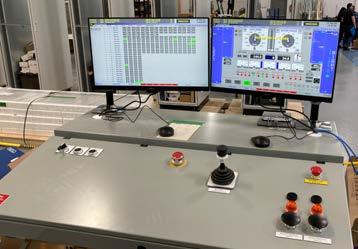
Galloway designs are inherently site-specific for any given shaft. The design and operation of these installations follow strict guidelines developed by Redpath. Recent ground-freezing shaft projects have required unique designs in and around the galloway, utilizing a center column support with a perimeter crane, supplemented with a movable deck to accommodate shaft liner installation in both tubbing and composite lined shafts.
An under-slung integrated hydraulic excavator type shaft mucker that provides the flexibility to cut, chip, or drill and blast frozen ground was a unique feature developed by Redpath.
The fourth generation of the unit is currently being developed for use in full remote mode, eliminating the need for personnel at the shaft bottom during the mucking (bogging/lashing) cycle. This new configuration features a moveable galloway deck, allowing the mucking unit to be positioned appropriately for shaft bottom mucking while also enabling concrete pouring concurrently with the main galloway above. This design ensures that the two critical operations can now function independently of each other.
During the sinking (kibbles) of the Saskatchewan potash shafts, Redpath developed a proprietary hydraulic stage-mounted shaft-mucking system called the S-20. Equipped with an Integrated Tool Package (ITP), this system provided Redpath crews with a flexible approach to the complex shaft sinking programs in the frozen ground.
This method, which has seen three iterations of the unit, with the latest being #5 shaft in Mongolia, has proven to be a safe and productive means of mucking shaft bottom. The S-20 has faced criticism, as any innovation might, but each new model has improved upon the previous versions. Redpath is currently utilizing a S-20 for a client in Canada on a deep hard-rock shaft, incorporating several upgrades into the design.
The success of the new mucking system can be largely attributed to the ease of operator training, safe finite control of mucking movements,
and the improved shaft bottom environment. Building on this success, Redpath embarked on an aggressive plan to rethink a mucking unit that could allow for safe, concurrent shaft works. This approach aimed to significantly reduce shaft schedules by enabling multiple work horizons within the shaft cycle and sequence. This initiative led to the design and development of the S-100 shaft mucker and its independent stage suspension system.
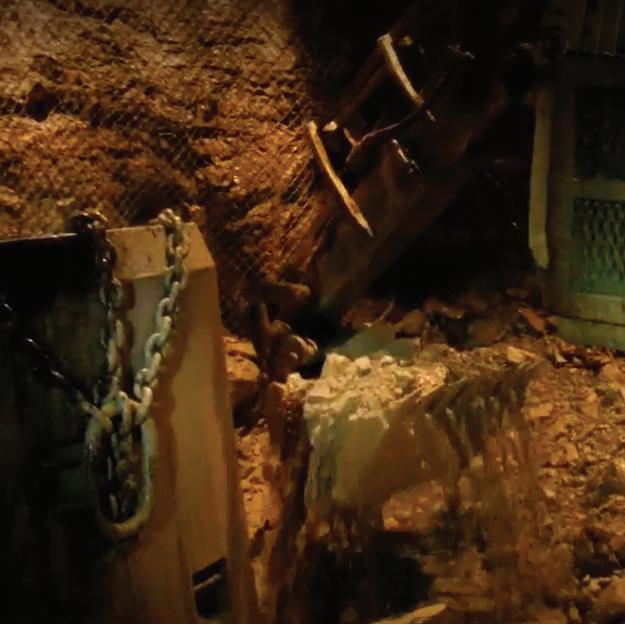

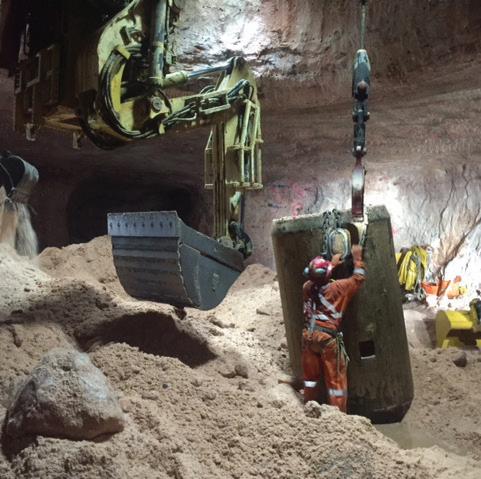
The second-generation hydraulic mucking system.
The third-generation hydraulic mucker was used to sink shaft #5 at the Oyu Tolgoi Mine in Mongolia.
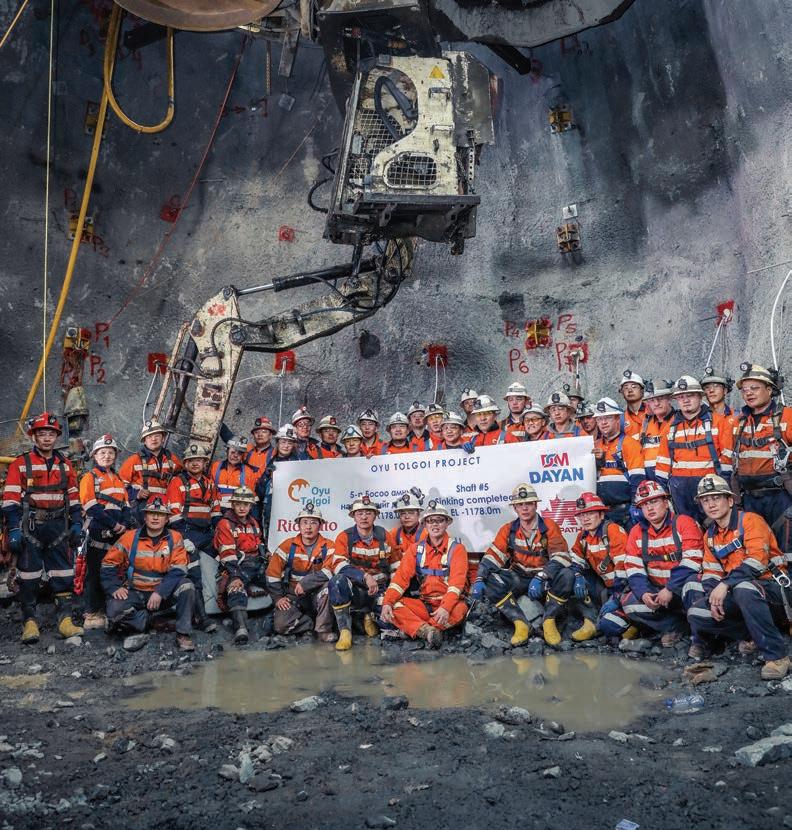
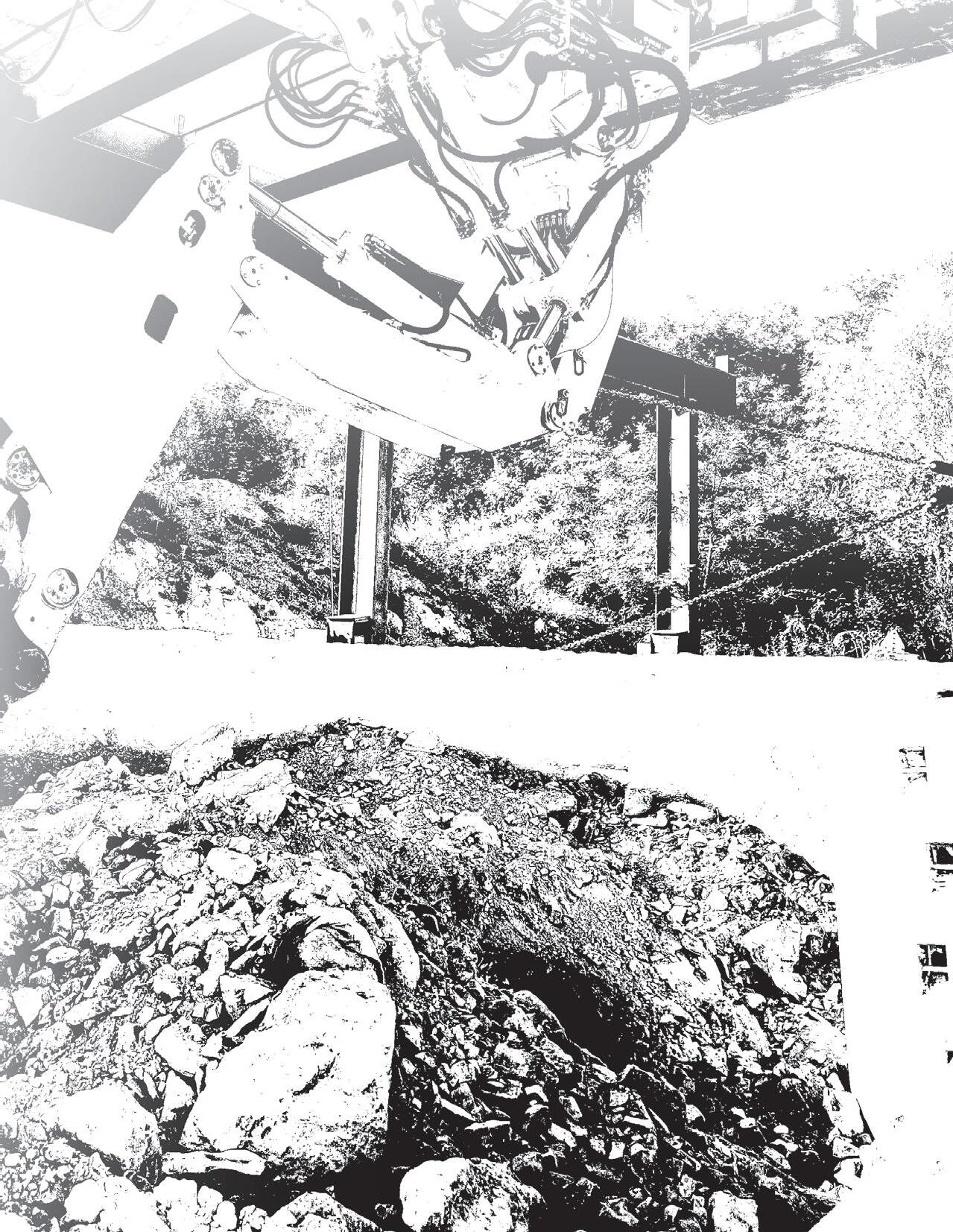
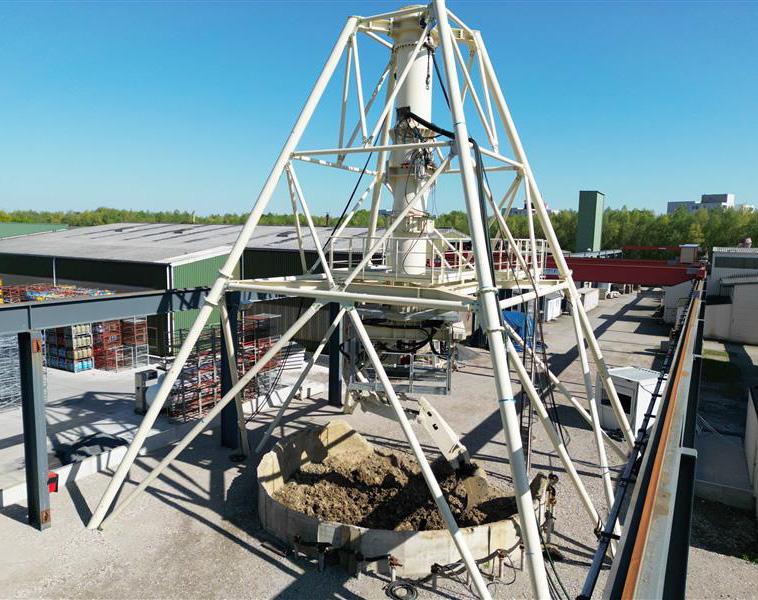
RD S-100 SHAFT MUCKER
Currently finishing the tower-mounted testing phase in Germany, where it was designed and assembled, Redpath has proposed the fourth generation of the stage-mounted hydraulic excavator shaft-mucking unit, called the S-100. This new model is a complete rethink of the original S-20 hydraulic mucker, incorporating lessons learned from previous iterations. Redpath has designed and built the prototype unit, and is in design for the independent telescoping stage suspension system.
The S-100 can be lowered from the main galloway, thus becoming independent of the main galloway elevations and tasks. The unit can be operated remotely, with no workers below the galloway as required, or operated from the mucking deck under the protection of the galloway. The
ability to conduct safe, concurrent work is expected to significantly shorten the shaft-sinking schedule.
Current challenges with the availability of trained, seasoned traditional shaft telescopic boom mucker operators are eliminated. The mucker can also be set in an “auto” mode, repeating the digging and loading sequence into the bucket. With an indexing function during the filling cycle, the mucker optimizes performance and minimizes spillage around the bucket. These functions have been preliminarily tested with success at our Dortmund, Germany facility.
The S-100 also offers the option of a quick-connect 2-boom drill that can commence drilling a pattern in “auto” mode. This auto mode option has not been tested to date. Redpath
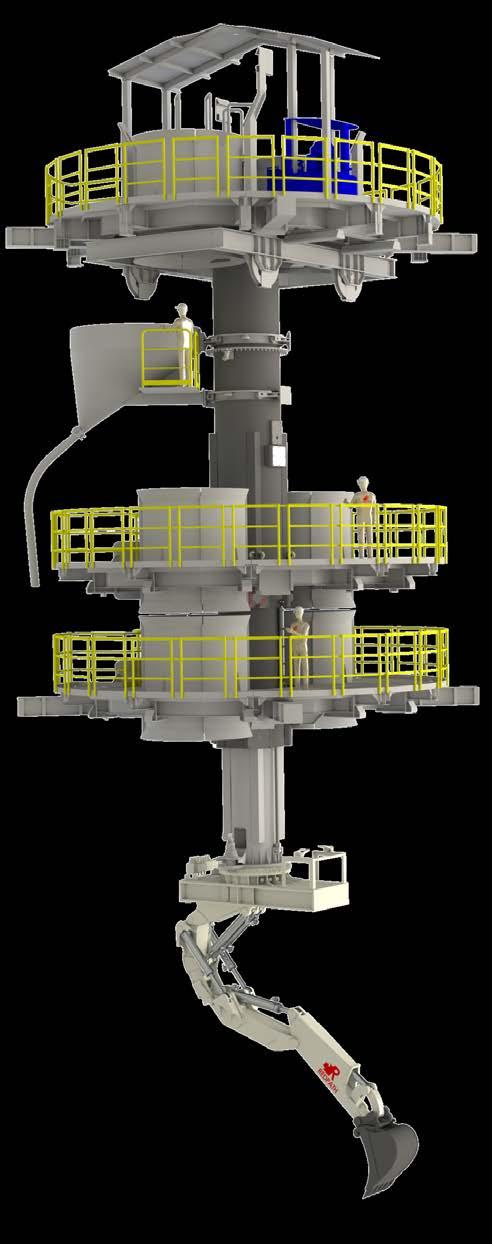
The highly versatile S100 is the latest addition to Redpath Deilmann’s shaft sinking services.
conceived the idea that drilling could also commence during other tasks, eliminating the need for workers on the bench. A long-hole cut machine is being discussed that would allow the entire cut to be completed before workers even return to the shaft bottom from installing services or performing other tasks.
The use of the mobile control console allows the S-100 to be operated from any location in the shaft-sinking vicinity. The easy-to-use controls resemble the functionality that many operators are familiar with when using a traditional excavator.
The Redpath hydraulic curb ring and shaft forms (shutters) key door, designed for use in shafts with profiled shaft walls, significantly decrease the effort required to set false flooring for concrete pours. This innovation eliminates the need for some of the more challenging manual scribing and the laborious manual key door opening and closing tasks, thereby enhancing safety.
Mucking can now be performed in two distinct phases: sequential and concurrent.
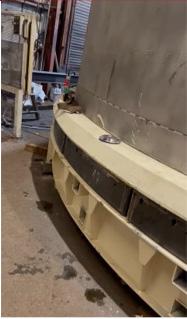
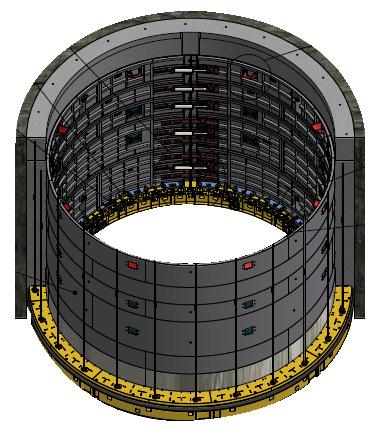
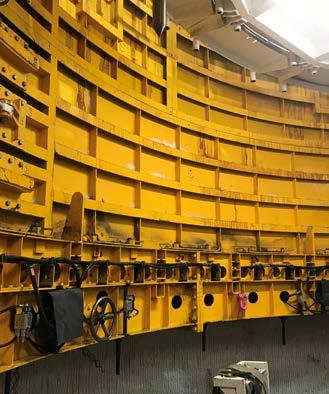
PROPRIETARY STEP -CHANGE METHODOLOGIES
Redpath has participated in several “Step Change” initiatives with equipment manufacturers in the shaft-sinking industry over the years. Recently, Redpath has teamed with a group led by Herrenknecht of Germany to develop the Shaft Boring Cutterhead (SBC). The two companies most recently collaborated on the successful Shaft Boring Roadheader (SBR) for soft rock environments. Redpath worked with Herrenknecht on site-specific design requirements and operating philosophies of the unit for a twin project in Belarus.
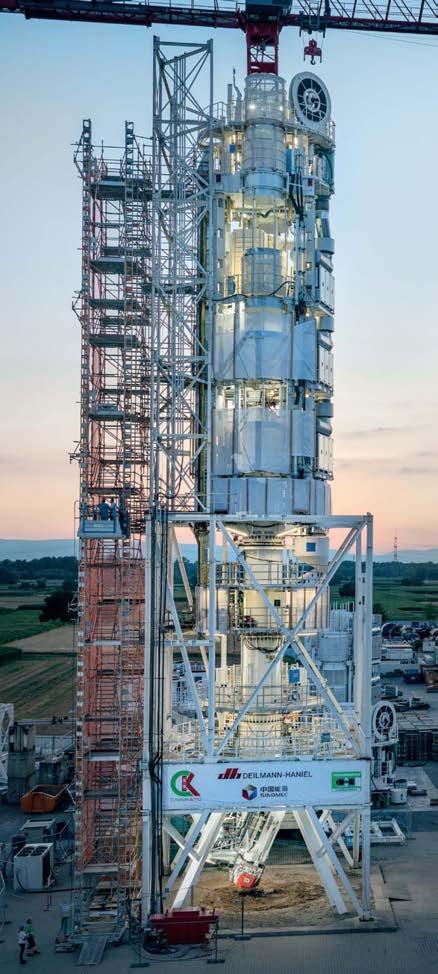
Shaft Boring Roadheader - SBR
Sinking and equipping of 2 cast iron tubbing lined freeze shafts
SHAFT NO 1
Skip shaft, air intake shaft
Inner diameter: 8.0 m
Freeze shaft depth: 160 m
Total shaft depth: 695 m
SHAFT NO 2
Man/material shaft, ventilation shaft
Inner diameter: 8.0 m
Freeze shaft depth: 160 m
Total shaft depth: 750 m
Client: Slavkaliy
Location: Luben, Soligorsk Region, Belarus
Duration: Nov 2017 - Jan 2021
The Shaft Boring Cutterhead (SBC) represents the latest concept of mechanized shaft sinking in hard rock conditions. The concept is a joint project between Herrenknecht and Redpath Deilmann and is based on the experiences from six past mechanized shaft sinking projects. The machine is able to carry out cutting, lining and mucking operations concurrently. An operational, to-scale built machine is located at Herrenknecht‘s facilities in Schwanau, Germany.
Photo credit, this section: Herrenknecht.

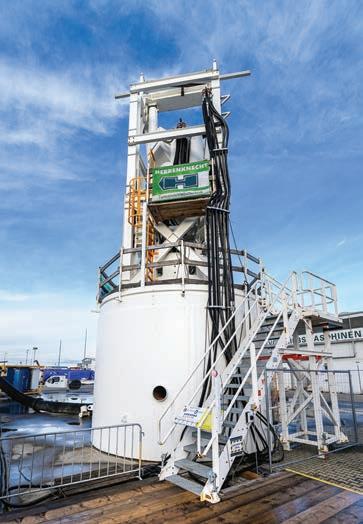

CURRENT SBC COLLABORATION - RESULTS
Excavation depth: up to 1,500 m
Excavation diameter: 7 – 10 m
Geology: medium to hard rock up to 250 Mpa
Drive: up to 3.5 rpm
Total weight: approx. 400 t
Muck transport: pneumatic system
Designed for daily advance rates of up to 6 m

